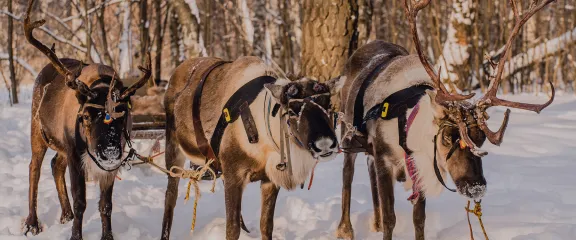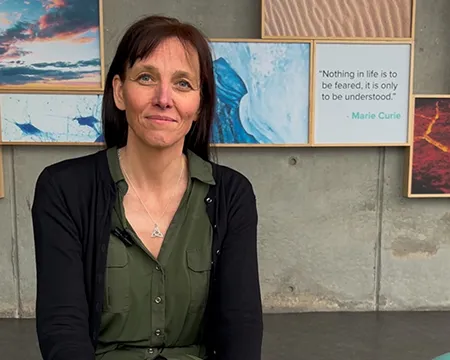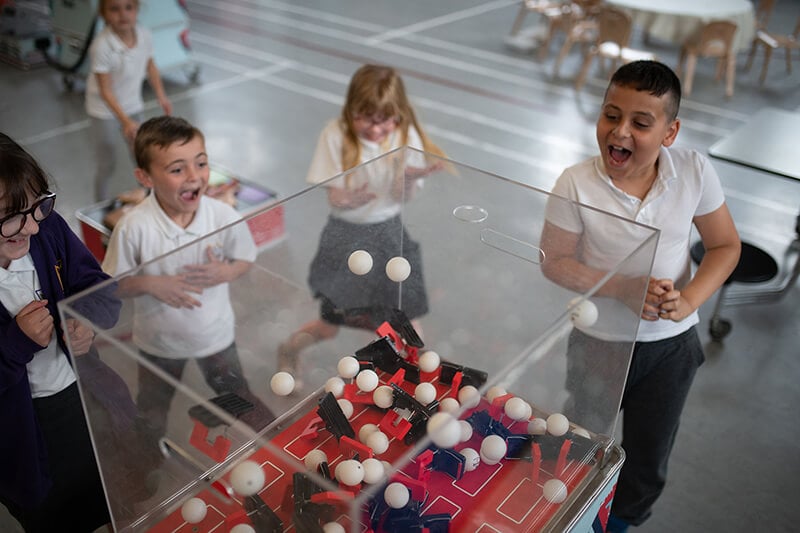Reindeer and their Arctic Adaptations

When winter descends in northern regions of our planet and the nights draw in, it’s time for us to retreat indoors. In the Arctic, this change is more extreme: the temperature can drop to a nippy minus 30 degrees Celsius and sunlight remains absent from this frozen landscape for five months of the year. There are few animals that can survive these harsh conditions, but one has adapted in several surprising ways to thrive in the extreme cold and prolonged darkness.
Remarkable reindeer vision
At first glance, reindeer may not seem that remarkable. Like most prey animals, they have eyes positioned on each side of their head to provide a wide field of view to spot predators. Their pupils are horizontal which allows them to focus their vision at ground level, where food can be found, and along the horizon, where predators might be lurking. But their eyes are also capable of a few science tricks.
In 2011, scientists made an astonishing discovery that shed new light on reindeer vision. They found that reindeer can see ultraviolet (UV) light which helps them to find food and evade predators. Reindeer feed on lichen that can be difficult to find in low light, but to reindeer, snow appears bright as it reflects UV light, and lichen appears dark as it absorbs UV light. Wolf fur also absorbs UV light which makes it easier for reindeer to spot a sneak attack.
It turns out this is quite a unique ability, as very few species of animal are known to use UV vision in this way. UV light is beyond the range of human vision. We can only see the wavelengths, or colours, of the rainbow, and we call this ‘visible light’. In fact, UV light carries much more energy than visible light and can damage our eyes. Other mammals such as dogs and cats can see UV light, but it’s unclear why. It may however explain your pet’s strange behaviour when they seem to see things that are invisible to you. Bees, and other pollinators, see the world in UV and they use this ability to see details on flowers that are invisible to us, but help them to locate tasty nectar.
More reindeer revelations
Scientists discovered another reindeer revelation in 2013. They found the wavelength of light reflected from the back of their eyes changes with the seasons. In summer, when their environment is bathed in sunlight, their eyes reflect more golden wavelengths of light. In winter, their eyes reflect more deep blue wavelengths of light. This happens as their eyes become more sensitive to the light levels of the season. This helps them to find food and spot predators when there is low light and offers protection for their eyes when light levels increase.
The Arctic adaptions of reindeer extend beyond their eyes.
A reindeer’s antlers are perhaps their most majestic feature. Both female and male reindeer have antlers, which is unique amongst deer species. But it is only females who keep their antlers during the winter months. This means that all of Santa’s reindeer are female!
Antlers have a large surface area that helps reindeer to regulate their body temperature. They can also be used to dig out food from the frozen ground. While other species may use fancy feathers or a dashing hairstyle, reindeer also use their antlers to attract a partner.
In the depths of winter, with icy Arctic temperatures, reindeer have the ultimate winter coat combination to keep them warm. They are covered head to hoof in two layers of hair: a dense undercoat and a loose outer coat in which every single hair is hollow. Air is trapped within the hair and provides excellent insulation. In the same way, wearing many layers is better than one thick layer of clothing. Reindeer are so well insulated that when they take a nap, they do not melt the snow beneath them.
Infrared interactivity at Glasgow Science Centre
At Glasgow Science Centre, as part of the Explore! exhibits on Floor 1, there is an infrared camera. Infrared wavelengths of light give us information about the temperature of an object. Come along and see how well insulated you are this winter and where you could do with adding an extra layer to keep warm.

Further Information
This blog post by Abi Jeorrett is adapted from an article by Glasgow Science Centre that first appeared in Glasgow Times in December 2022.






